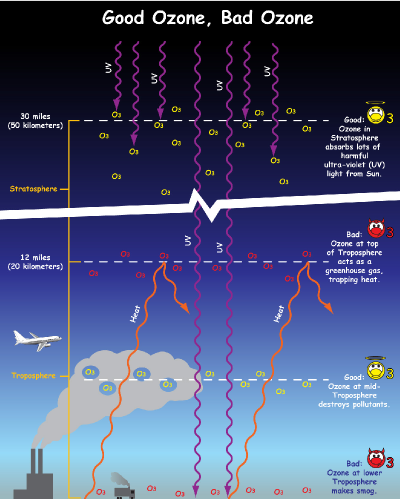Ozone, the Greenhouse Gas
We all know that ozone in the stratosphere blocks harmful ultraviolet sunlight, and perhaps some people know that ozone at the Earth's surface is itself harmful, damaging people's lungs and contributing to smog.
But did you know that ozone also acts as a potent greenhouse gas? At middle altitudes between the ground and the stratosphere, ozone captures heat much as carbon dioxide does.
In fact, pound for pound, ozone is about 3000 times stronger as a greenhouse gas than CO2. So even though there's much less ozone at middle altitudes than CO2, it still packs a considerable punch. Ozone traps up to one-third as much heat as the better known culprit in climate change.
Scientists now have an unprecedented view of this mid-altitude ozone thanks to an instrument aboard NASA's Aura satellite called the Tropospheric Emission Spectrometer—“TES” for short.

Ozone behaves differently at different altitudes in the atmosphere. High in the stratosphere and at mid-troposphere it has positive effects on life at the surface. At the top of the troposphere ozone is a greenhouse gas and at the surface it makes smog
Most satellites can measure only the total amount of ozone in a vertical column of air. They can't distinguish between helpful ozone in the stratosphere, harmful ozone at the ground, and heat-trapping ozone in between. By looking sideways toward Earth’s horizon, a few satellites have managed to probe the vertical distribution of ozone, but only to the bottom of the stratosphere.
Unlike the others, TES can measure the distribution of ozone all the way down to the heat-trapping middle altitudes. "We see vertical information in ozone that nobody else has measured before from space," says Annmarie Eldering, Deputy Principal Investigator for TES.
The global perspective offered by an orbiting satellite is especially important for ozone. Ozone is highly reactive. It is constantly being created and destroyed by photochemical reactions in the atmosphere and by lightning. So its concentration varies from region to region, from season to season, and as the wind blows.
Data from TES show that ozone's heat-trapping effect is greatest in the spring, when intensifying sunlight and warming temperatures fuel the reactions that generate ozone. Most of ozone's contribution to the greenhouse effect occurs within 45 degrees latitude from the equator.
Increasing industrialization, particularly in the developing world, could lead to an increase in mid-altitude ozone, Eldering says. Cars and coal-fired power plants release air pollutants that later react to produce more ozone.
"There's concern that overall background levels are slowly increasing over time," Eldering says. TES will continue to monitor these trends, she says, keeping a careful eye on ozone, the greenhouse gas.
Learn more about TES and the science of ozone. Kids can get a great introduction to good ozone and bad ozone
This article was provided by the Jet Propulsion Laboratory, California Institute of Technology, under a contract with the National Aeronautics and Space Administration.